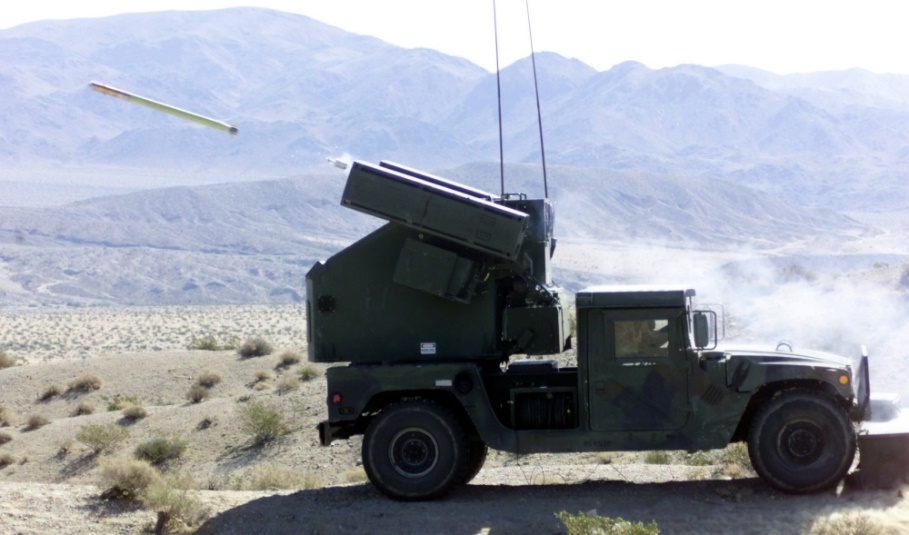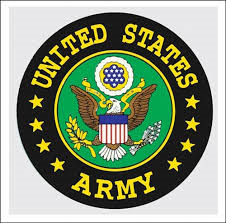
United States Army
The United States Army is a large and powerful force; technologically advanced, generally well trained, and held at a relatively high state of readiness. The 1980’s was a decade of change for the US Army. Coming out of the Viet Nam era, the now professional (vice conscript) force adopted new organizations, new training methods, new equipment, new tactics and overall a completely new concept of integrating combat power. The US Army of 1994 had been tested during Operation Desert Shield/Storm in Iraq and, although there was some improvement to make, proved to a great extent that the reforms had worked beyond the imagination and expectations of most.
The US Army in Europe through the latter part of the Cold war was the focus of the entire army structure. Led by 7th Army HQ, two full Corps (V & VII) were largely stationed in Germany with a third Corps (III Corps) based in the US but having pre-positioned equipment holdings in POMCUS (Prepositioning Of Materiel Configured in Unit Sets) sites. Although problematic due to maintenance, cost, security and standardization, this system was exercised rigorously in the annual REFORGER (REturn of FORces to GERmany) Exercises. By 1989 the POMCUS system was set up to rapidly deploy six divisions, support elements and logistics to Germany, within 10 days, to reinforce the four divisions permanently stationed there. Historically this system came to a sudden end following the Gulf War, when VII Corps and over half of the forces in Germany were repatriated and rapidly deactivated.
In the Northern Fury world the US Army has experienced some difficulty obtaining consistent and clear government direction since the fall of the Berlin wall. The massive effort in the Gulf War was supposed to be the closing act to the Germany based VII Corps which, due to budgetary pressure, was due to deactivate in the early ‘90s. The increased tension from a resurgent Soviet Union has interrupted that plan mid stride – inconvenient for both military and budgetary planners. The end result is that some repatriation has occurred but some plans were canceled and others modified. The main points of impact are:
7th US Army HQ remains in Europe (double hatted as CENTAG HQ)
The 18 Division structure established by the Reagan administration remains, therefore
2nd Armored Division is not deactivated (planned for 1995)
3rd Armored Division is not deactivated (in 1992)
5th Infantry Division (Mech) is not deactivated (in 1992)
6th Infantry Division (Light) is not deactivated (originally reduced to one brigade in 94, removed in 98)
7th Infantry Division (Light) is not deactivated (in 1994)
8th Infantry Division (Mech) is not deactivated (in 1992)
9th Infantry Division (Light) is not deactivated (in 1991)
Additionally, all National Guard and Army Reserve ‘Training’ Divisions remain intact.
VII US Corps HQ remains in Europe but with a reduced staff and structure:
1st Armored Division moved to the US with 3rd Brigade remaining in Germany
3rd Infantry Division moved to the US with 3rd Brigade remaining in Germany
77nd and 210th Artillery Brigades moved to the US with a POMCUS site in Germany
7th Combat Engineer Brigade is transferred from VII Corps to 7th Army and remains in Germany
197th Infantry Brigade (REFORGER) is transferred to 7th Army as CENTAG reserve
207th Military Intelligence Brigade is transferred to 7th Army for general support and remains in Germany
The ‘Berlin’ Brigade is due to deactivate in July of 1994.
56th Artillery Brigade, has exchanged its deactivated Pershing missile systems for M270 MLRS armed with MGM-140 ATacMS (Army Tactical Missile System) and remains a direct reporting unit to 7th Army HQ.
The POMCUS program was expanded to include six more Brigade size sets of equipment; 2 for 1st Armored Division, 2 for 3rd Infantry Division, and 2 for the two artillery brigades.
In order to maintain enhanced security in Kuwait, 187th Infantry Brigade Army Reserve has been activated. This is a unique structure as Battlegroup size elements from the standing army, National Guard and Reserve rotate through the Brigade on an 8-month tour of duty. While in Kuwait they undergo a rigorous training program to enhance their combat capability.
It should be noted that divisions based solely in the continental US (CONUS) except 82nd Airborne and 101st Air Assault Divisions, only had two active brigades. The third brigade was either National Guard or Army Reserve and these, although equipped the same as the active units, would take a minimum of 30 days to deploy.
During the turmoil of the post ‘Gulf War’ redeployment, manning in the Army remained relatively constant. Although there was an initial dip in strength due to planned downsizing in 91-92, this has largely been made up by 1993. The strength as of Jan 1994 is slightly smaller than its recent peak in the late ‘80s but about 200,000 more than historic - totals for the US Army in Northern Fury are:
Army: 755,000
Army National Guard: 450,000
Army Reserve: 582,000
Structure
Within the CONUS there are six army level HQs (1st Army to 6th Army), these are primarily tasked in a mobilization role in times of national crisis but can be activated for operations such as 3rd Army in the Gulf war. The two active armies, 7th Army in Europe and 8th Army in Korea are on full operational status. Within CONUS all active duty units are assigned to Corps and most have a wartime deployment role. The Corps in CONUS are:
I Corps
This is a small Corps charged with experimentation and development, but has emergency deployment tasks. It is likely that I Corp would deploy to US Army Pacific, probably with 7th Infantry Division (ID) and its artillery, aviation and air defence brigades. 9th ID is a very unique formation; it is the testbed light wheeled vehicles and rapid ground mobility. This division was earmarked to deploy to Northern Germany or Denmark, however its lightly armored infantry ((HMMWV or Desert Patrol Vehicles), combined with only having two tanks battalions (in its National Guard round-out brigade) may have precluded its employment on that front. Its high speed cross country mobility, on the other hand made the unit ideal for desert operations, and its relative lack of heavy equipment made it suitable for complex terrain such as jungle, densely forested areas or even mountains.

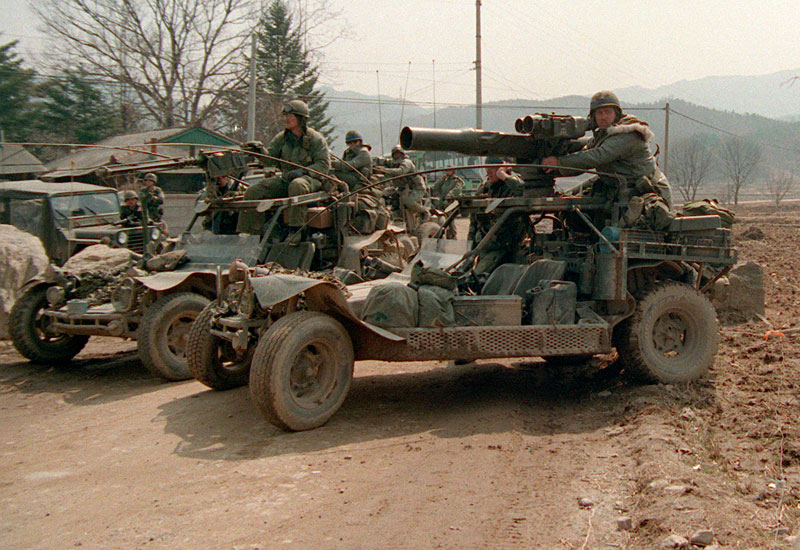
III Corps
The complete opposite of I Corps, this corps is a massive organization which is destined for Europe in its entirety. III Corps, in addition to its own formations, is a holding organization for 7th Army in Europe and holds most of the heavy mechanized and armored formations stationed in the US. Divisions tasked with rapidly reinforcing both of the Europe based Corps through REFORGER, are held under command of III Corps for training and administration but, their parent Corps maintain operational command. Operationally, III Corps will deploy to northern Germany and operate as part of NORTHAG (British Army on the Rhine) while formations supporting V & VII Corps will be under command of CENTAG (7th US Army).
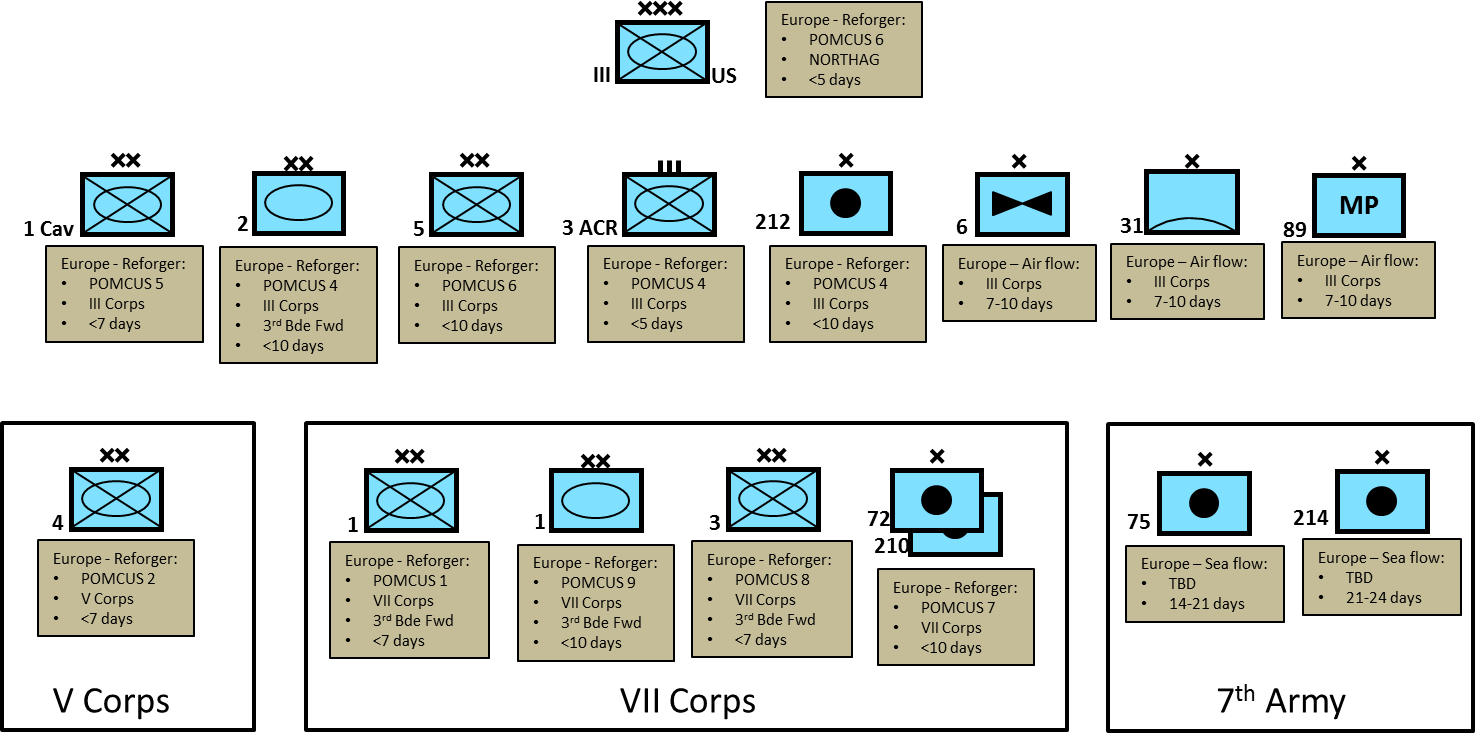
It is worth noting that the POMCUS policy was to move 6, now 8 divisions to Germany in less than 10 days: 1st Cav, 1st ID, 1st AD, 2nd AD, 3rd ID, 4th ID, 5th ID, 194th Armd Bde*, 197th Inf Bde*, 3 ACR, 212th FA Bde plus two more FA Bdes for Northern Fury. The last division (unless you count the three independent Bdes as a division) is 9th ID from I Corps, which would fly over in its entirety. The feasibility of all but the 9th ID deployment was well practiced, as discussed earlier, 9th ID was not well suited to the north German plain. (*From XVIII Airborne Corps below).
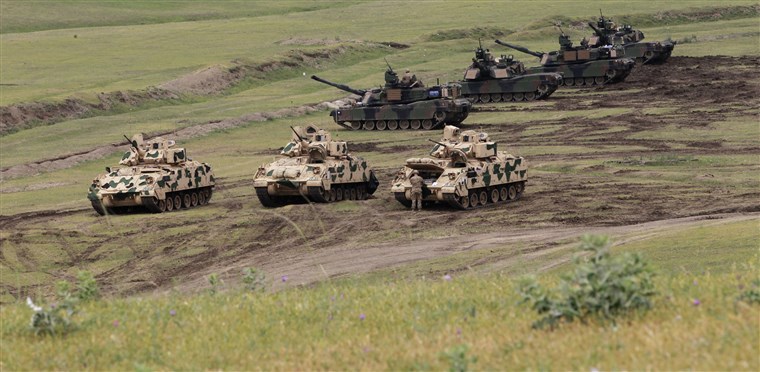
XVIII Airborne Corps
Commonly referred to as ‘America's Contingency Corps’ this organization has seen a lot of recent action and deployed to the Sini peninsula in 1982, Grenada in 1983, Panama in 1989 and the Gulf war in 1991. Similar to III Corps above, this formation is also charged with holding elements destined for Europe, but the main elements of the corps are its three rapid deployment divisions, each one unique. 82nd Airborne Division has a battalion task force on 24 hours notice to move anywhere on the globe, at all times, and the remainder of a brigade moving within 3 days. The 101st Air Assault Division maintains an aviation brigade with over 320 helicopters; more than most nations operate. 10th Mountain Division is capable of moving by air to anywhere in the world within 10 days. 10th Mountain has a National Guard round-out brigade but both of the other divisions are fully manned standing army units. 24th ID it tasked for a European deployment and will move, less the 48th National Guard round-out Brigade, by sealift with a delivery time of 14 days, this is the only formation entirely relying on sea lift. The two independent brigades will deploy to Europe as discussed above.
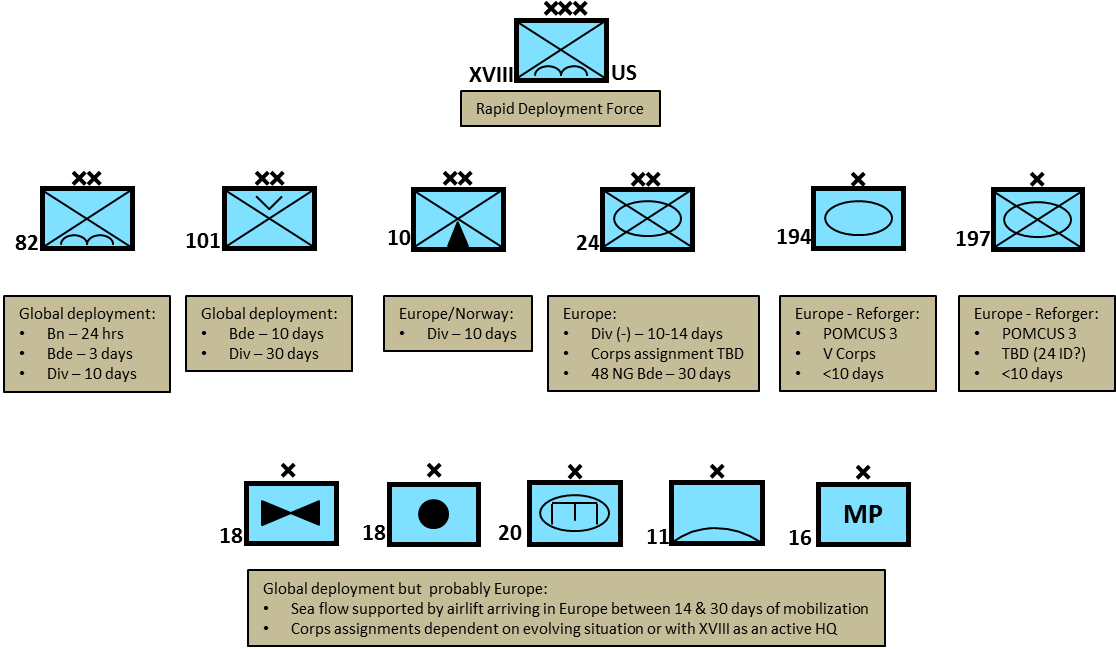
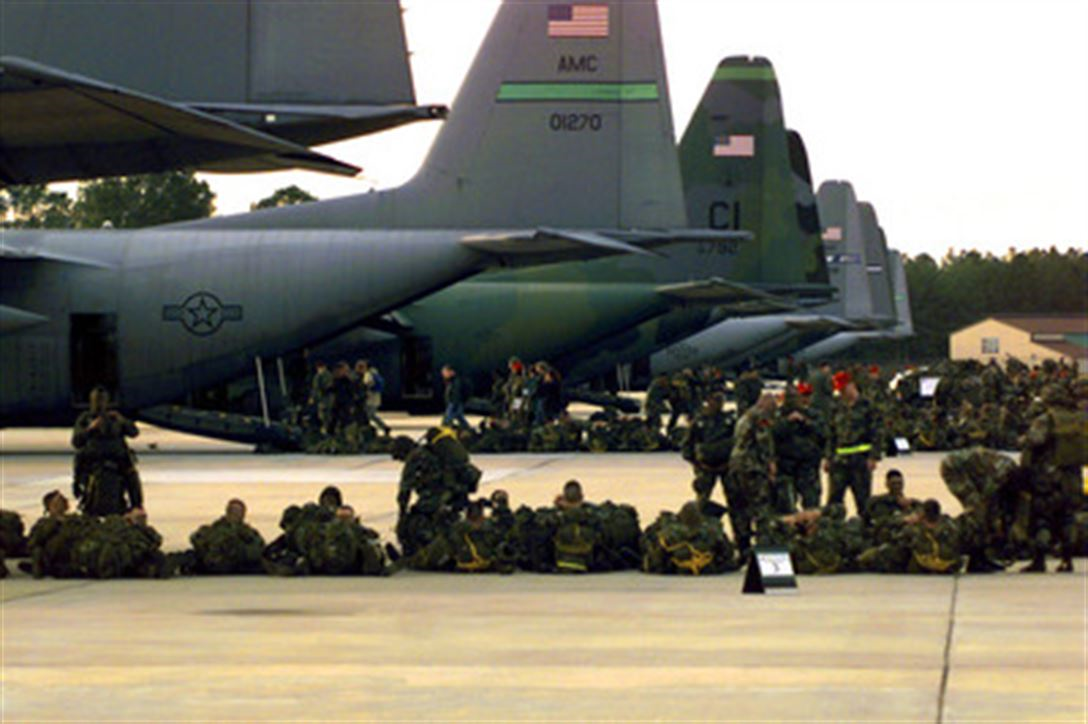
US Army Europe
Commanded by 7th Army HQ, also acting as NATO CENTAG, these two Corps and supporting units have been the focal point of US Army training and development since the end of the Korean War. After the post-Gulf War reductions this force is at its lowest point in terms of manning since 1950, with only two fully manned divisions, six independent or forward positioned brigades and two armored cavalry regiments. Given 10 days to mobilize, 7th Army or CENTAG would be a powerful force indeed, with 10 American, 7 German, 3 French and one Canadian division at its disposal. Ten days is a long time in a modern conflict however.
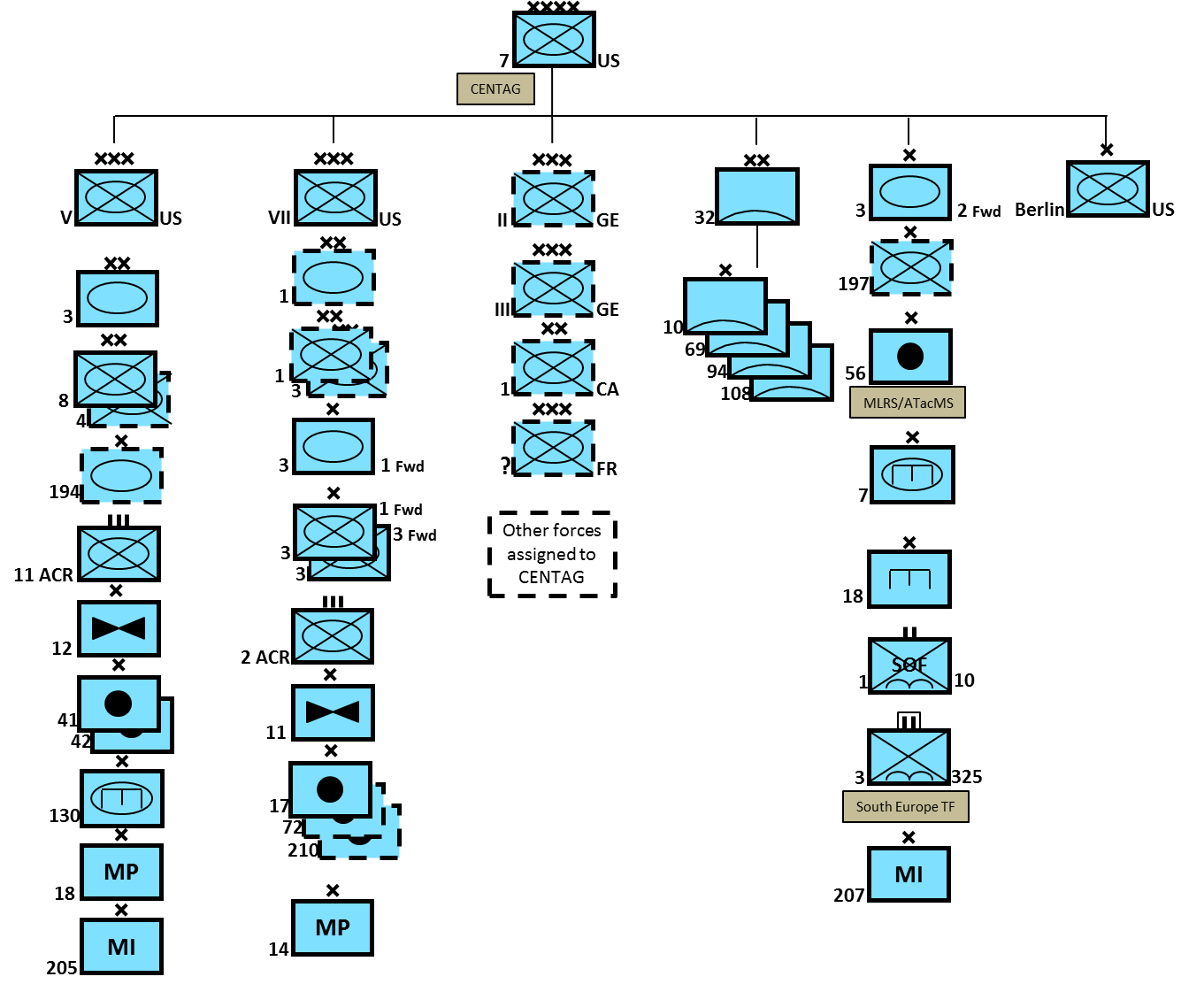
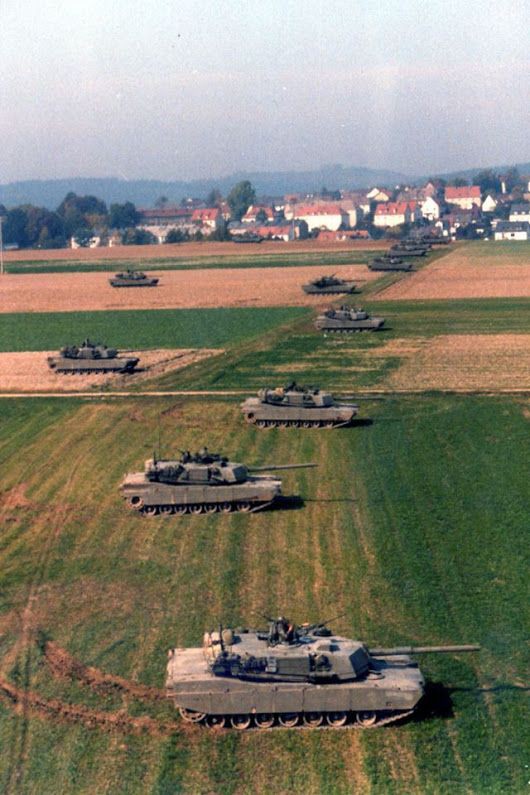
US Army Pacific
US Army Pacific is a diverse and dispersed organization. Commanded by Commander 8th Army with his HQ in South Korea and having forces in Alaska, Hawaii and Japan, this army relies very heavily on its allies and the USAF to add armor and firepower to the fight.
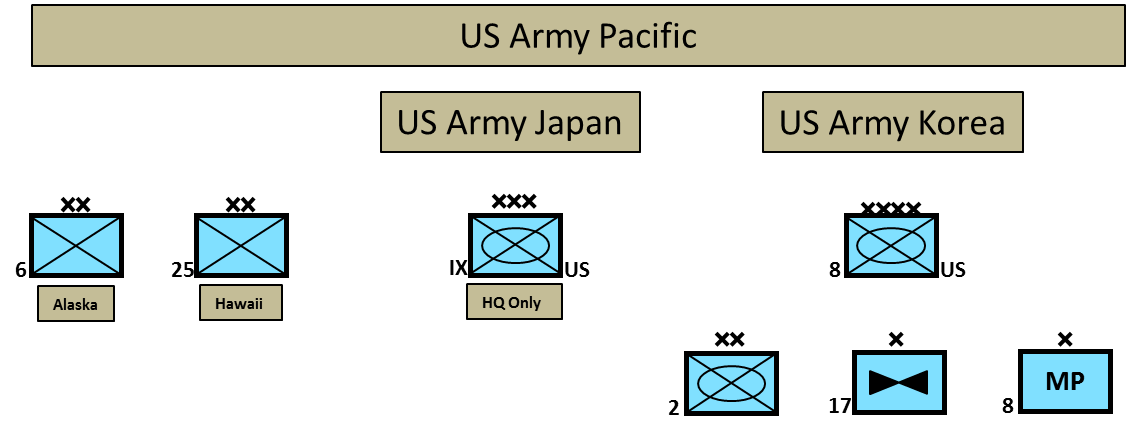
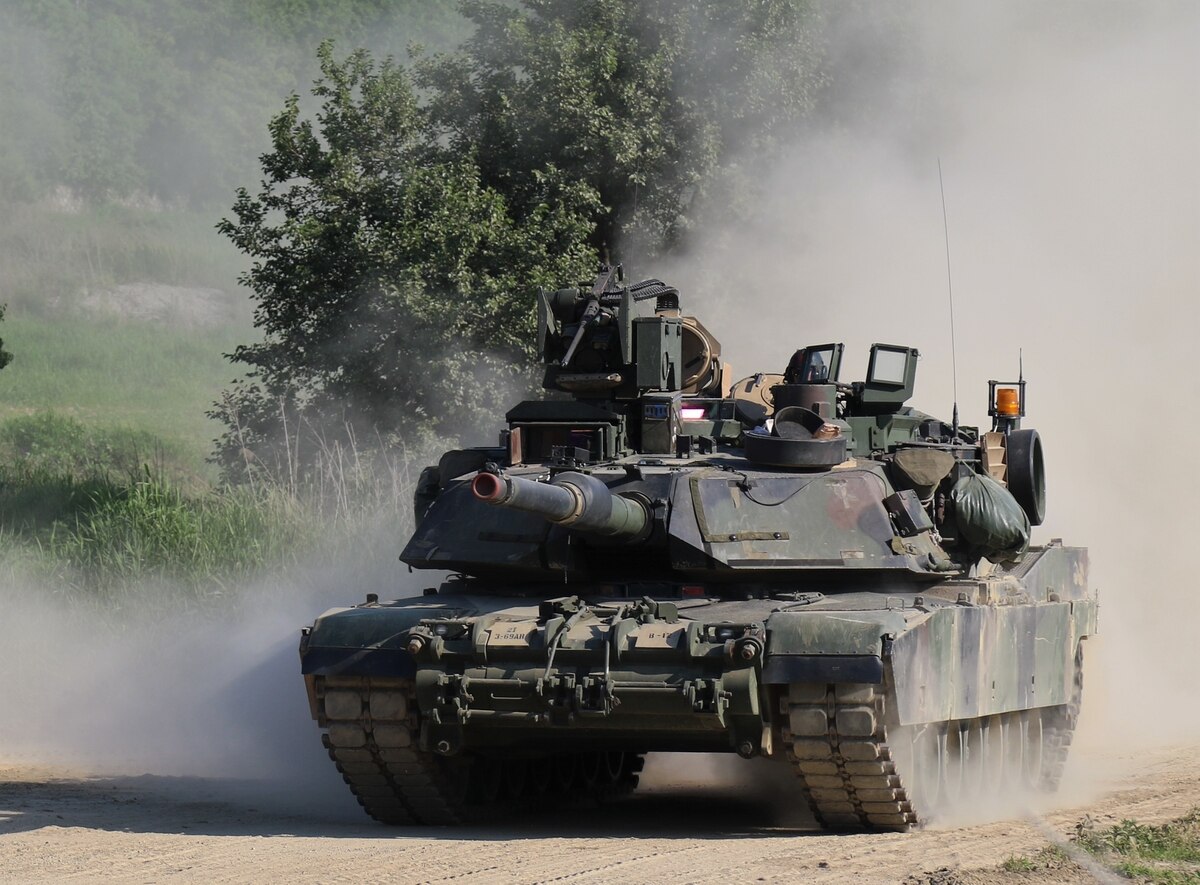
US Army South
The 193rd Infantry Brigade is the only regular army unit in this command. The primary purpose of this brigade is security of the Panama Canal Zone, but it also assists the Panamanian Government and other US agencies in conducting counter insurgency and counter narcotics operations.
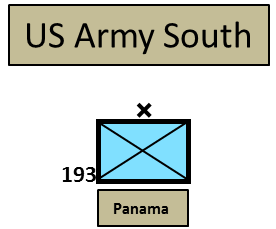
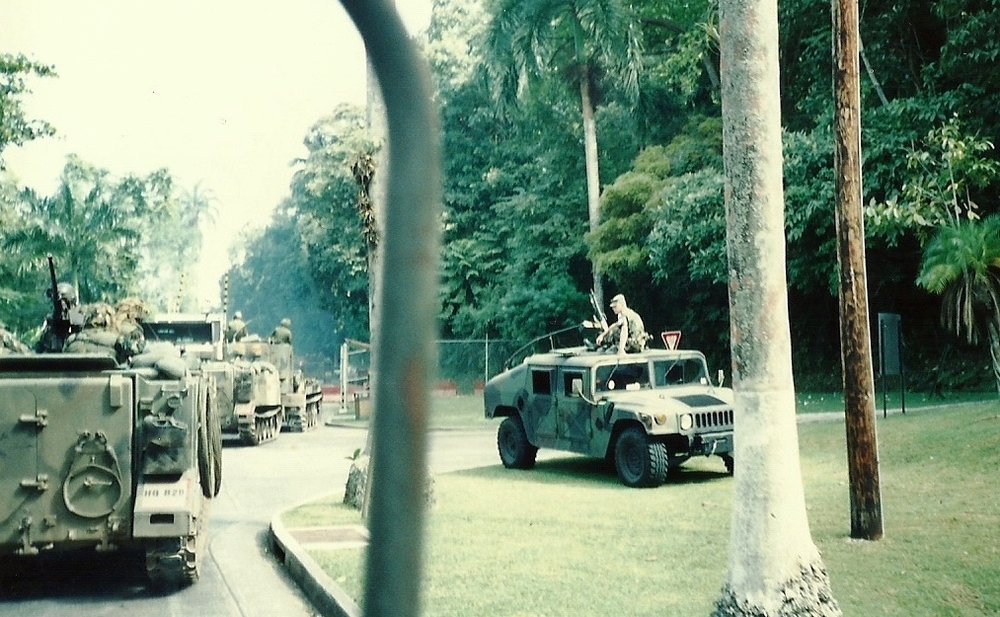
US Army Kuwait
In the three years following the Gulf War, tensions in the region have increased, primarily because Iran has become increasingly hostile towards the West and Iraq. In all likelihood this resurgent hostility is linked to improved Iranian relations with the Soviet Union. Therefore, in order to maintain enhanced security in Kuwait, the 187th Infantry Brigade, US Army Reserve has been activated. The brigade is a shining example of the ‘Total Force’ concept within the US Army; the HQ, an infantry battalion, 5-5th Artillery Battalion HQ and one battery, Engineer Company and Cavalry Troop are from the Army Reserve, while the regular army and the National Guard provide a battalion and an artillery battery each to the force. Each of the three battalions rotates in for an 8-month tour of duty and mans in-place equipment, conducts an intensive training program and then returns home. The battalions rotate at 4 month intervals and routinely train with Kuwaiti and Saudi forces.
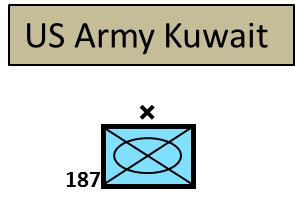
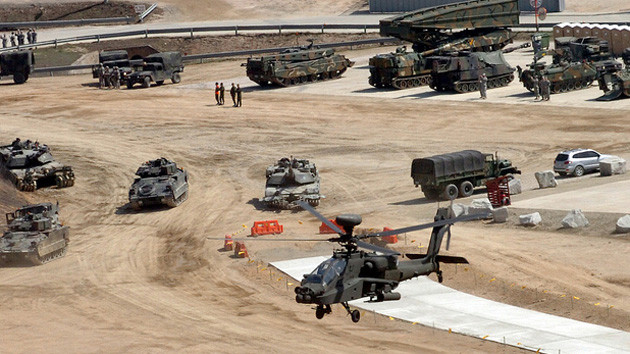
US Army Special Operations Command
The US Army Special Operations Command (USA SOC) is a relatively new organization, formed in 1989 when all Special Forces were place under the control of the United States Special Operations Command (SOCOM). This force, trains, equips, maintains and deploys Special Forces elements worldwide in response to national priorities. Combined with US Navy and US Air Force Special Operations elements operating under the control of SOCOM, it can precipitate strategic effect with a comparatively minor force commitment.

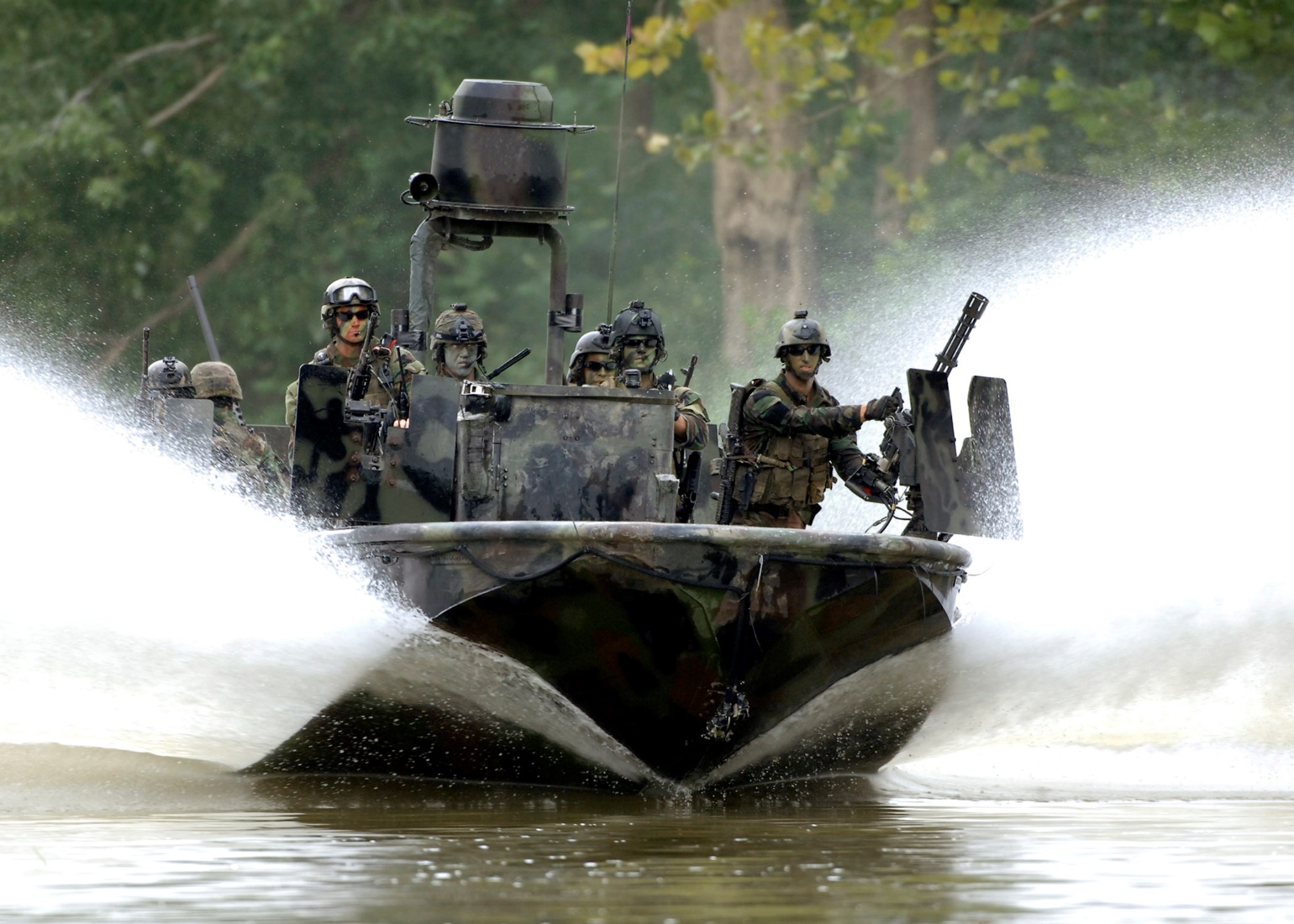
US Army Reserve
The Army Reserve is a force of 582,000 personnel, 1/3rd of the total strength of the army. Although the vast majority are ‘part time’ soldiers, they are well trained and equipped, subject to immediate recall and many have regular army experience. Part of the reserve structure are the 10 ‘Training Division’ HQs, their primary function is to be a focus for mobilization, training and equipping mobilized troops, and perhaps commanding those troops as a follow on formation or providing replacements for battle losses. Another factor to consider when examining the diagram below, logistics units are not included and a large portion of the Army Reserve form logistics organisations.
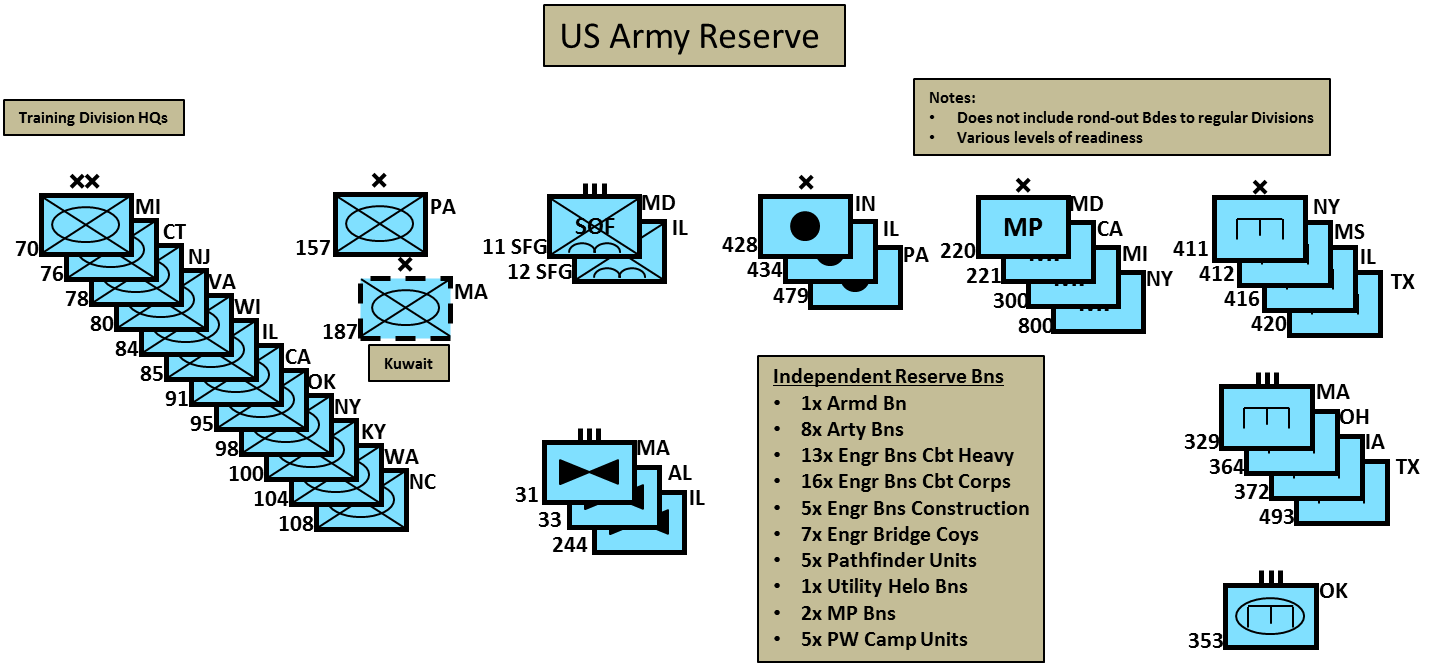
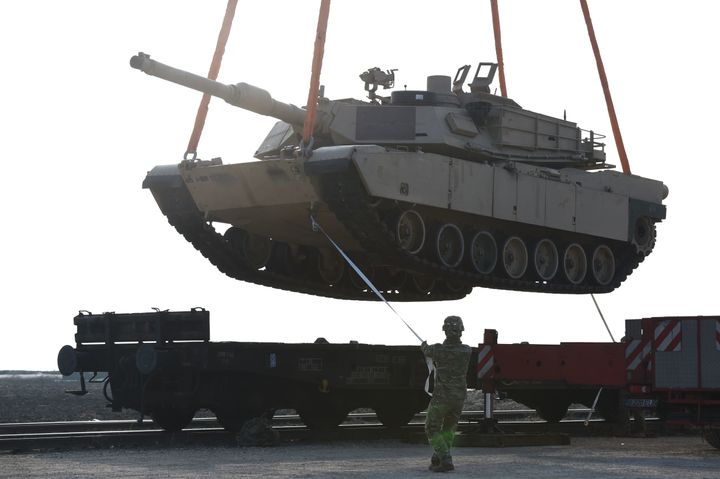
The US Army National Guard
The National Guard (NG) represents 25% of the deployable army and is a fundamental element in the ability of the US Army to succeed in battle. Over 60,000 National Guardsmen deployed to the Gulf War including two formed artillery brigades. The Gulf War also pointed out some shortcomings in NG readiness and a program has been put in place to rectify these. Some units are equipped with the latest generation of equipment while most use slightly older kit, but even that is the same or better than some NATO allies. Four of the NG division HQs, as well as the IX Corps HQ, at least one artillery brigade and probably several other elements have a follow on reinforcement role to NATO. Readiness levels have improved since the Gulf War as have training programs. Most units should be ready to deploy within 30-45 days of mobilization while some will take up to 60 days of training with some re-equipping. It is likely that more than 50,000 NG troops will deploy individually or in small units within the first 14 days of mobilization including up to five artillery brigades, two engineer brigades and one or two aviation brigades.
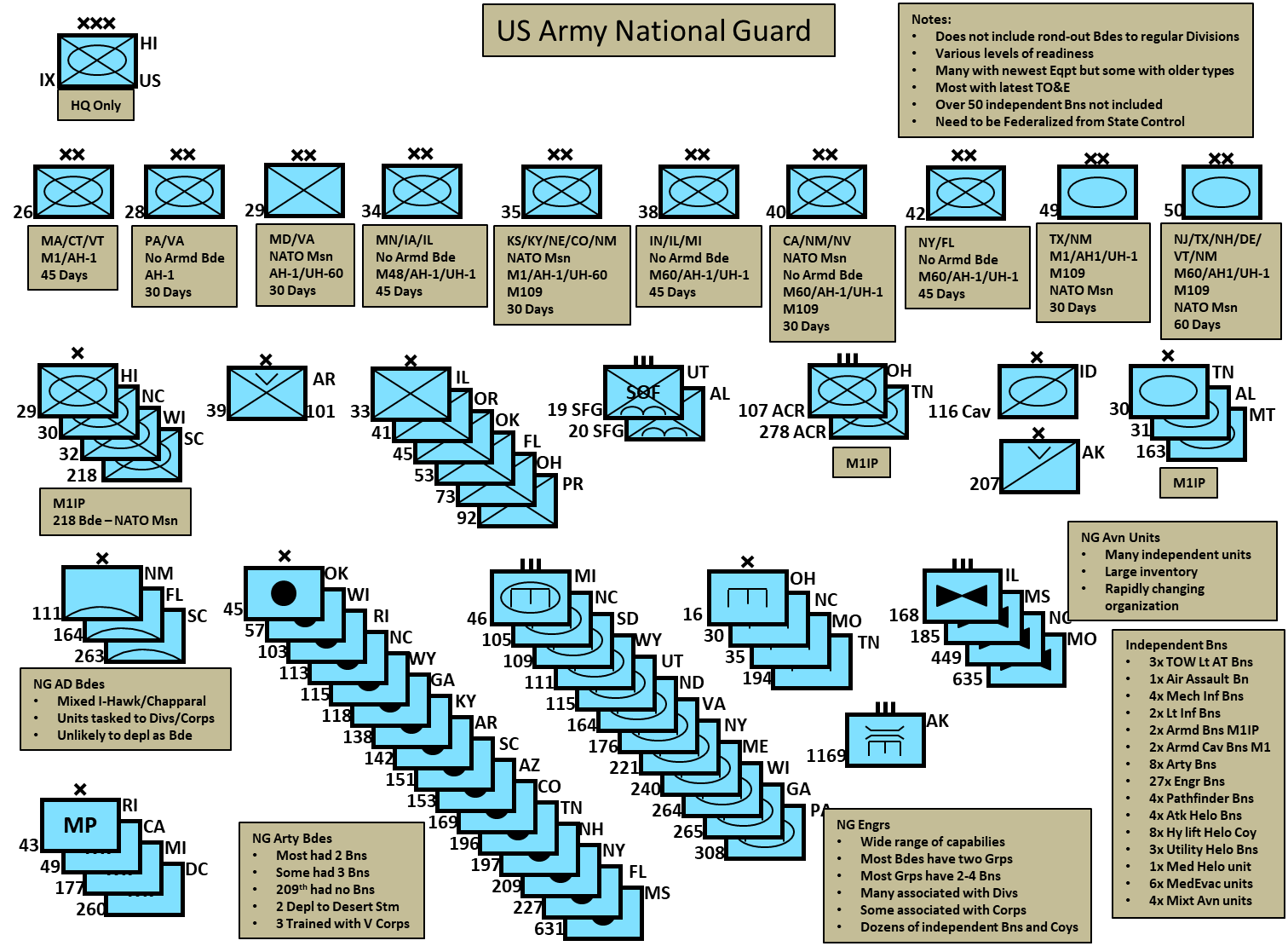
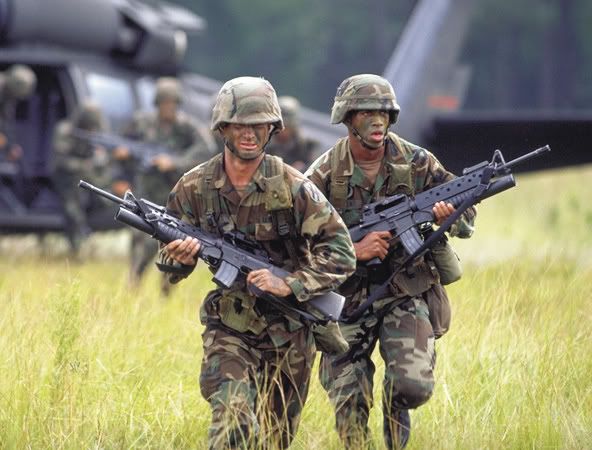
Equipment
Main Battle Tank (MBT)
M1: The extremely successful M1 Abrams MBT began production in 1979 and continued through 1985 when the last of 3,273 were produced for the US Army. A 61 ton reliable, well proven tank with a 105mm rifled gun, it can travel at 45 MPH (72 KPH) and has a range of 310 miles (500 Km). In comparison to others this is an excellent, tank, it has the same gun as the Leopard 1, but is 50% heavier and also has a shorter operational range. The main concern with this MBT is high fuel usage requiring additional logistic support. After sales to Kuwait and Saudi Arabia, upgrades to later variants and general attrition are factored in; there are 1630 basic M1s available to the US Army in 1994.
M1IP: This version has improved engine performance, efficiency, and better turret armor but in most other ways is the same as the M1. There were 894 produced.
M1A1: This tank, in addition to other improvements, replaced the gun with the 120mm Smooth bore cannon, the same gun used by the Leopard 2. In comparison the M1A1 is heavier but achieves the same speed (42 MPH/68 KPH) over a longer distance 288 miles (463 Km) versus the Leopard 2 which achieves a range of 211 miles (340 Km). By 1992 there were 4,976 M1A1s produced.
M1A2: Upgraded M1s to a similar configuration as the M1A1 in particular upgrading the gun, these also had a second thermal site for the commander allowing rapid engagement subsequent targets at night or in obscured conditions. Total available in early 1994 is 1,190 including 190 new production and about 1000 upgraded versions.
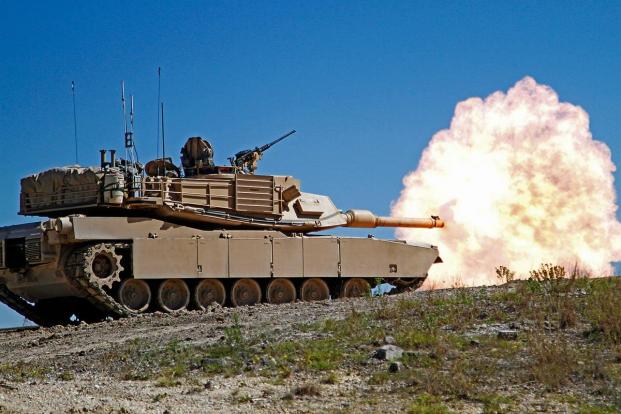
M60A3: Built in the 1980s, the latest version of the ‘Patton’ MBT carried the same British made L7, 105mm riffled gun as the M1 Abrams, with a fire control system that produced a 70% hit probability of another tank at 2000 meters. By the time production stopped over 1700 had been built and another 1700 older models had been converted to this standard.
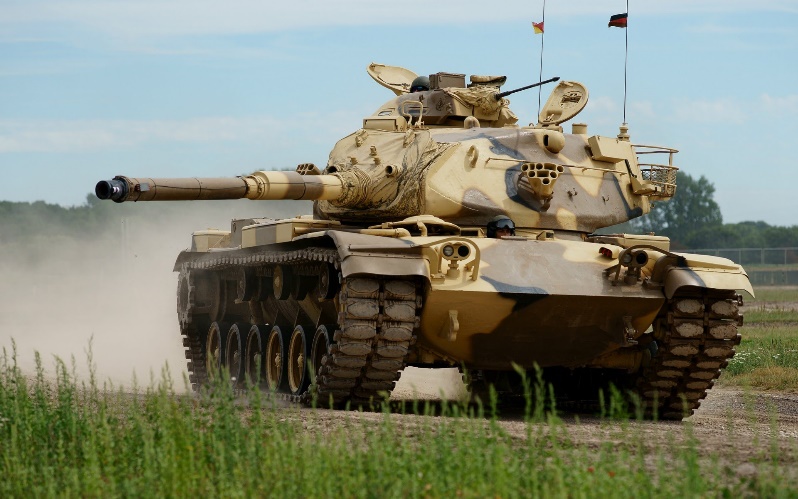
Disposition of MBTs
As the M1A2 Abrams continues production, an ongoing program is cascading newer MBTs across the entire army. Formations assigned to REFORGER have a higher requirement as they need to provide a fill set of equipment to the POMCUS site, while maintaining a partial set for training in CONUS. Formation assigned to 7th Army Europe, both permanently stationed and REFORGER units require approximately 5,300 MBTs, including 1,800 tanks based in CONUS for training will cascade to NG units upon mobilization. Other active army users such as I Corps, 24th ID and PACOM require another 500 MBTs. All of these units are also equipped with the M1A1 or M1A2 Abrams MBTs. Army Reserve elements, NG independent armored battalions and brigades as well as the armored battalions in independent infantry brigades and armored cavalry regiments are equipped with the M1IP. The remaining formations are a mix of basic M1 MBTs and M60A3s.
M1A1 & A2: Total 6,166: 5300 for Europe & REFORGER; 500 for PACOM & 24ID, remainder to CONUS forces.
M1IP: 894: Reserve, NG & CONUS forces.
M1: 1630: Reserve & NG.
M60A3: 3400: Mostly NG.
Armored support vehicles
All armored support vehicles are based on the M60 chassis. Although some support vehicles based on the M1 are in development, they are several years from fielding. These are spread throughout the force:
312 x M728 Combat Engineer Vehicle (CEV).
400 x M60 Armored Vehicle Launched Bridge (AVLB).
1,427 x M88A1 Armored Recovery Vehicles (ARV).
896 x M88 upgraded to A1 standard.
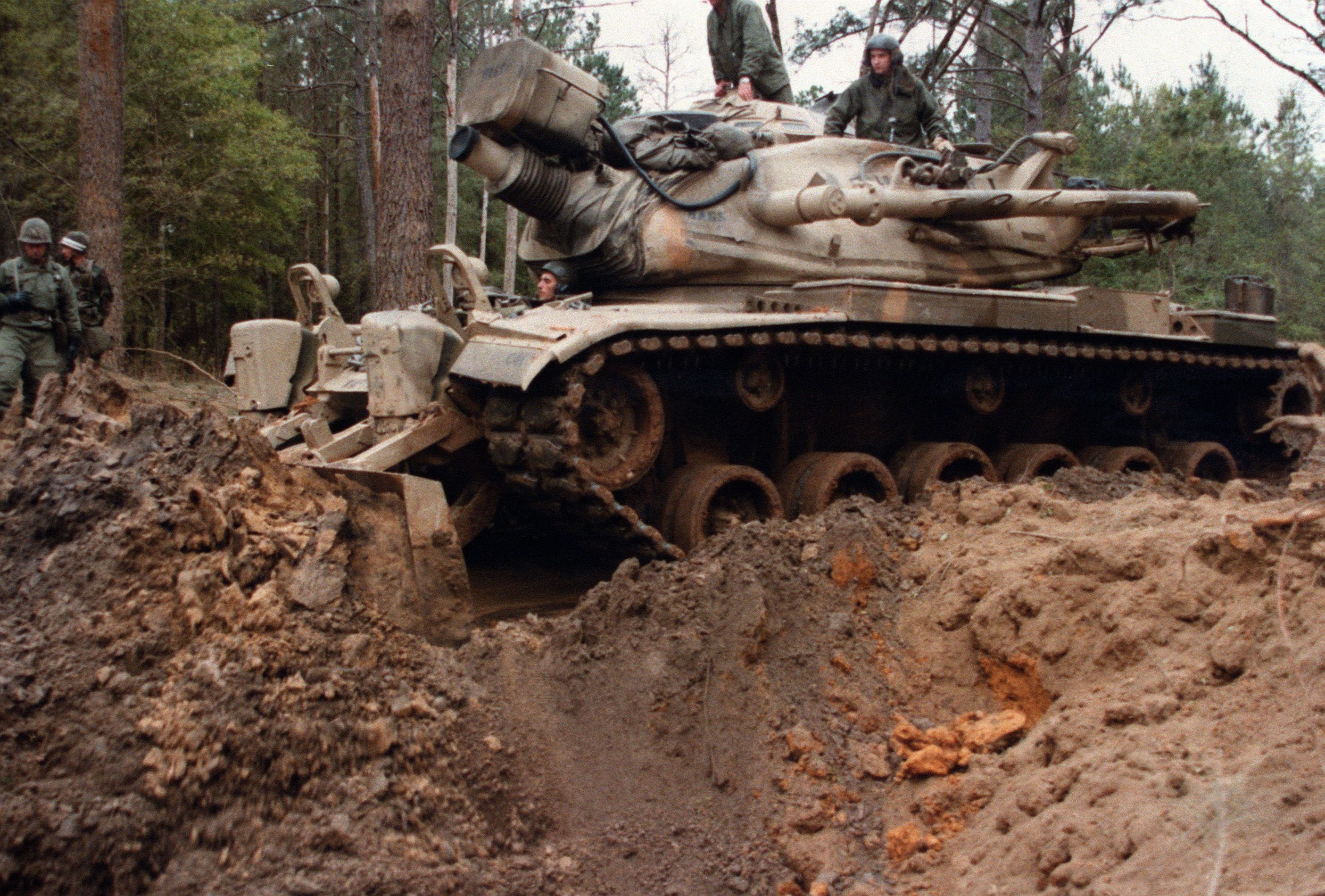
M2 Bradley Infantry Fighting Vehicle (IFV)
The Bradley is the standard infantry vehicle in the mechanized forces of the US Army. It is armed with a 25mm ‘Bushmaster’ chain gun, has a crew of three and carries six soldiers able to dismount to clear the enemy. By 1994 initial production was complete and upgrading older versions to meet the latest standard was underway, this is several months faster then happened historically. In total 4,641 M2s were built with over half being built to the A2 ‘high survivability’ standard. All but the first 1,600 A0 variants also carried a TOW 2 missile launch system. M2 disposition is roughly equivalent to the M1A2 laydown, with Germany based units and POMCUS sites having the latest A2 variants and CONUS based units, Reserve or NG having the A1 and A0 versions.
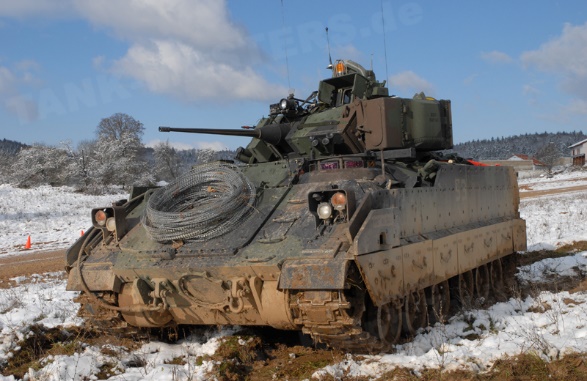
M3 Bradly Cavalry Fighting Vehicle (CFV)
Almost identical to the M2 in appearance, the M3 only carries two dismounts, with the remainder of the space used for extra radios, storage and ammunition for the TOW missile systems. In all, 2,083 CFVs were built and issued to all armored cavalry units, including NG units. These had the same variant details as the M2 and once again, Germany has the latest equipment while the older variants requiring refit are in CONUS.
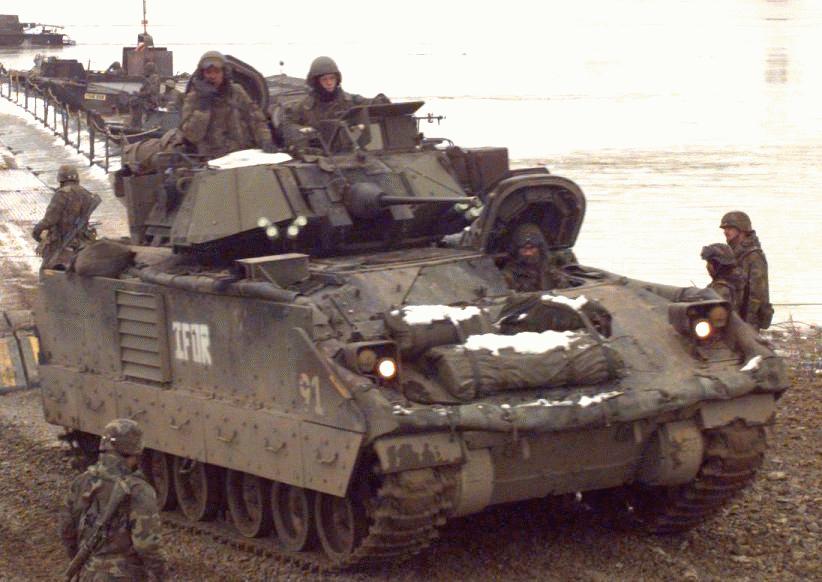
M113 Armored Personnel Carrier (APC) Family
This versatile and reliable family of vehicles has been in use for over 30 years in the US Army and has found its way into over 50 other armies around the world. Some 34,000, primarily the standard ‘Battlefield Taxi’ variant were produced for the US, while over 80,000 were produced worldwide. These vehicles are used in virtually every mechanized unit in the army and are often pushed into roles they were not designed for. In 1994 the following are in the inventory:
Approximately 16,000 x A1, A2 or A3 variant; standard troop carrier.
1,600 x M113A4 Armored Medical Evacuation Vehicle (AMEV). Ambulance when translated to English.
1950 x M106 mortar carriers with 107mm (4.2in) mortars.
1275 x M125 mortar carriers with 81mm mortars.
4000+ x M548 ammunition carrier.
5000+ x M577 command post vehicle.
3300 x M901 Self Propelled (SP) TOW-2 missile launchers.
1000+ x M981 Fire Support Team Vehicle (FIST V)
600 x M730A2 Guided Missile Equipment Carrier (Chaparral)
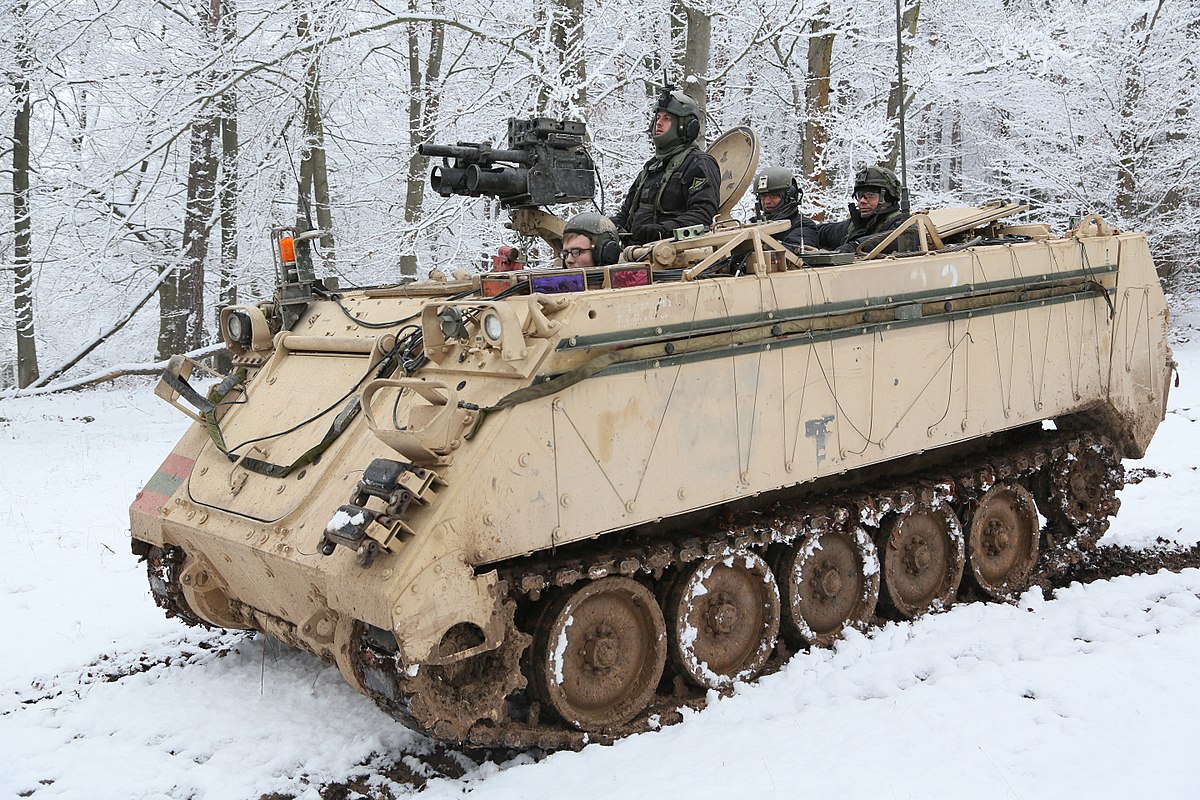
Artillery
The US Army has vast quantities of artillery systems to outfit the 48 artillery brigades across the force. Each division has a DivArty Brigade generally consisting of a 155mm battalion with 18 guns working as Close Support to each maneuver brigade, plus a battery of MLRS (M270 Multiple Launch Rocket System) and a target acquisition battery in General Support. 82nd and 101st divisions have 105mm Close Support battalions and a 155mm General Support Battalion using M198 towed howitzers. The 30 independent brigades have a wide range of configurations and are meant to provide the Corps and Army commanders flexibility by supporting the main effort divisions with extra fire power. Key artillery systems are:
150 x M119 (Light Gun) towed, air portable 105mm howitzers.
2,400+ x M109A2/A3/A4 SP 155mm howitzers.
<100 x M109A6 Paladin SP Autonomous howitzers (24th ID).
1000+ x M198 towed 155mm howitzers.
526 x M114 towed 155mm howitzers.
1046 x M110A2 SP 203mm howitzers.
750+ x M270 SP MLRS (replacing all Lance and Pershing systems)
35- x MGM-52 Lance SSMs, conventional warheads only, retiring.
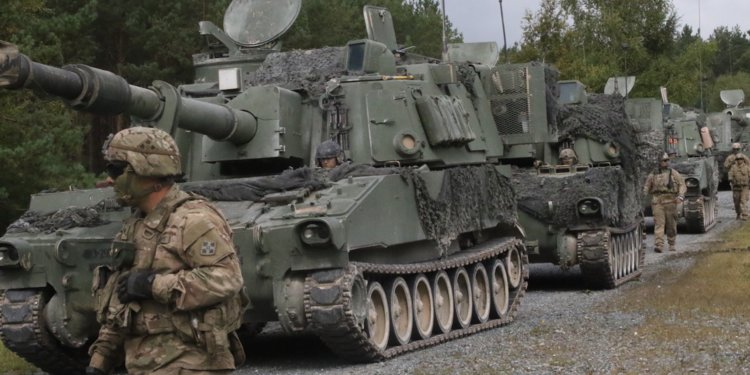
Air Defence systems
The 10 Air Defence Artillery (ADA) brigades across the army are allocated roughly one per Corps with additional brigades under army control. There are some independent units supporting fixed installations. Each brigade is unique and task tailored for the rolls and responsibilities it has been given. Generally, US Army ADA is focused on the High Level and the Very Low Level air defence threats, leaving medium level threats to other nations or NATO air forces to deal with. The systems in inventory are:
220 x M167 towed 20mm Vulcan.
360 x M163 SP 20mm Vulcan.
1060 x Stinger missile launchers (13,000 missiles).
500+ x Avenger HUMMWV mounted Stinger missile launcher.
600 x Chaparral SP.
500+ x MIM-104 Patriot SP High level missile system
400+ x I-Hawk towed High level missile system
